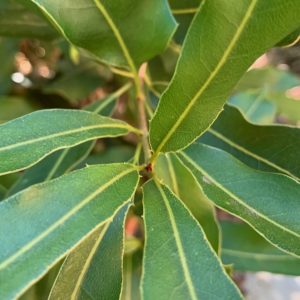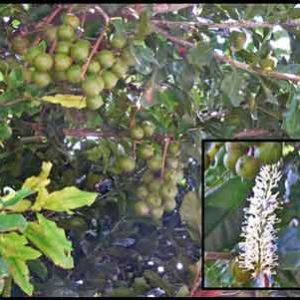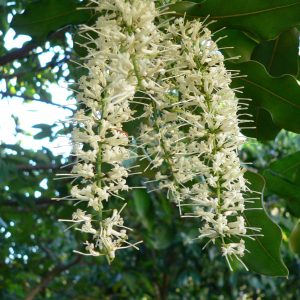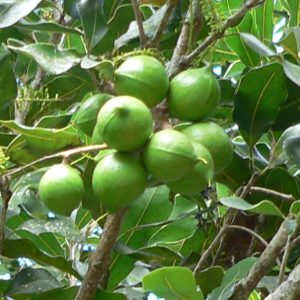Macadamia integrifolia
Macadamia, Queensland nut
Origin
Macadamia is native to rain forest areas of South Eastern Queensland and North eastern NSW, but is now grown in many other countries including Hawaii, South Africa, Guatemala and Brazil. Australia is now the major (>40%) worldwide producer, but it was in Hawaii where it was successfully developed into an important commercial crop.
Climate
It grows well within 34 degrees of the Equator, with optimal temperatures of 13-30°C and well-distributed precipitation of 1200-2300mm pa. Drier periods are preferred during flowering and early fruit set. Trees are frost sensitive when young, slightly less so when mature. In Perth there is often some leaf scorch on west-facing leaves (caused by hot dry weather, and fierce afternoon sun).
Plant Description
Trees are evergreen, long-lived, 14-18m tall but grafted plants less, with a canopy almost as wide if unpruned. Dense leaves are light green or bronze when young, changing to shiny dark green with maturity. They can be 10-25cm long, obovate and with an entire or spiny margin, the latter being more pronounced in tetraphylla (MT). Leaves appear in whorls of 3 or 4 for integrifolia (MI) and MT respectively. Growth occurs in a series of flushes in warmer months.
Relatives
Proteaceae Family. This is largely a southern hemisphere family of trees, shrubs and herbs; some other edible ones are the gevuina, red bopple nuts and the Atherton oak. There are more than 10 species in the genus Macadamia. Care should be taken with the lesser-known species because they may need special processing to be made non-toxic.
Soils
Preference for well-drained soils, not overly fertile, pH 5.5-6.5. They will cope up to pH 7-8 but trace element nutrition may then need attention. Mulching is beneficial to retain moisture and nutrients, and also to inhibit soil pathogens.
Propagation
Superior plants are almost universally propagated by grafting; success rates improve if the scion is girdled a few weeks before severing. Seedlings of MI are usually used as rootstocks; although MT seedlings are more vigorous and resistant to Phytophthora, they often have long term incompatibility problems. Most orchards in Australia are primarily based on MI and MI x MT hybrids. Newer DNA fingerprinting techniques have shown that even the so-called pure species of MI and MT have a proportion of their genome from the other species.
Cultivars
Many of these are identified by number, plus those developed later have their history in the pioneering Hawaiian breeding programs. In Australia, a large proportion of commercial cvs are hybrids. Some varieties that you may be able to source are: MI – 246, 741, 816, A38, H2, Own Choice and Daddow; hybrids – A4, A268, A16, Beaumont, Renown, and Guros. Performance of particular cvs varies greatly with location, environment, climate etc.
Flowering and Pollination
Inflorescences are long pendant racemes with several flowers in a whorl at each node. The rachis is 6-250cm long, bearing up to 300 perfect apetalous individual flowers, 10mm long, with 4 petaloid sepals forming a perianth tube. There are 4 stamens surrounding the pistil which has a single-carpelled ovary, 2 ovules and a 10mm long style. Usually MI flowers are white and MT pink. Night temperatures of 12-18C are best for flower induction. Most inflorescences, terminal or axillary, are formed on 2-3 year old wood in August to October, with mature trees producing up to 8000 racemes. Flowers are protandrous with maximum pollen germination 3 days after anthesis. Cultivars have variable self-sterility; of those fruit that are set, only 10% may be self-pollinated. This is improved with cross-pollination. Bees and other insects are the main pollinators; wind is likely a minor contributor.
Cultivation
They should be planted in full sun but will tolerate some shade as their origin is as an understory tree. Although in the Proteaceae, they still need their P (NPK ratios that the plant requires/absorbs not too different to other tree crops, 10:1:8).
Once a dry period induces fruit set, they need water for proper maturation. Keep weeds from competing.
Wind Tolerance
Branches can be brittle in strong winds. This can be alleviated by selective pruning of weak narrow crotch angle branches and appropriate sheltering.
Pruning
Leader forms of growth with whorls of wide crotch angle scaffold branches are preferred and best established while the tree is young. Inevitably some pruning will be required to control size and height. The key feature to keep in mind regarding yield is light interception – if this is markedly reduced then yield will decline.
The Fruit
This is a dehiscent follicle that splits along a single suture in the pericarp (husk). The extremely hard kernel shell is actually derived from the seed testa. MI shells are ‘smooth’ and those of MT ‘rough’. Kernels consist of 75% oils, most of which are the healthy monounsaturated types, good levels of Mg and 13% carbohydrates.
Fruit Production and Harvesting
Seedlings could take 8-12 years to begin fruiting with a variable quality outcome whereas grafted trees may take less than half this time with more predictable results. Yield will increase steadily over several years. Fruit set with cross pollination may be as high as 35% but less than 1% develop into mature nuts, even less in higher temperatures. Nuts take 30-35 weeks to mature from anthesis, with harvest in Mar-Jun. Mature nuts usually abscise and drop to the ground when they should be regularly collected. The staggered harvest period is of advantage to the home grower. They should be dehusked within a few days and then air-dried for a few weeks before attempting to crack them. With good management and conditions, a mature tree can produce 20-40kg of nut-in-shell.
Fruit Uses
Although home growers often eat the kernels as is, flavour is much enhanced when they are roasted, and it is this form that most commerce is based on, either as nuts or in confectionary or bakery items. Extracted oil is also produced. MI nuts are easier to process than MT nuts which contain more oil and sugar and hence are more prone to go rancid and to scorch during roasting.
Pests and Diseases
Major pests can be macadamia nut borer and flower caterpillar, fruit spotting bug, rats and the larger cockatoos. Diseases may include root rots (Phytophthora and other pathogens), blossom blight and husk spot.
Comments
Macadamia grows well in the south west of WA if moisture levels are managed appropriately. Only named cvs should be planted if the goal is yield; the more self-fertile the better. Dried nuts-in-shell keep very well, and when combined with staggered harvesting the delicious reward is long-lived. Yield will be improved if there is space to accommodate different cv trees or if single, tree grafting is undertaken. Roasting for the home grower is straightforward and well worth the effort.
More Information
Macadamias – Australia’s contribution to the world’s fruits and nuts
Considering the thousands of edible tropical and sub-tropical fruits known worldwide, the USDA has suggested that only 300 of these are commercially important and less than 100 contribute to most production and consumption. Of fruits from Australia, the macadamia nut is the only one that makes these lists. Possible reasons for this laggard performance include firstly that our continent is the driest and has been relatively isolated botanically for a long time. As a consequence we don’t have anything like the diversity and profusion of edible and palatable species found in Asia and the Americas. Secondly, our indigenous people have had a nomadic lifestyle for thousands of years that did not gradually improve the stock by selection of occasional superior trees as happened more often elsewhere. As a result, our limited native bush foods have remained basically in their original unimproved forms, and consumption of the best of them remains largely at the fringes of society.
However despite these negatives, numerous surveys and personal evaluation have usually judged the macadamia to be the tastiest of all the commercial nuts. They taste good raw and even better roasted, but most of the world’s crop is eaten in more processed forms such as chocolate-coated kernels, nut-impregnated chocolates, muffins, pies etc. It was the Hawaiians who first realised their commercial potential, did the development work on them over several decades to produce superior cv’s and then built up a successful industry. Only then did we belatedly decide to get operations going here on our own native plant!
Macadamias have an extremely strong shell which is more difficult to crack than other tree nuts. For the home user this usually means that many kernels are fractured during preparation. Like all nuts, un-broken kernels command higher retail prices than fragments and commercial crackers can give a better proportion of unbroken nuts than that achieved by the home-user. As with cashews which have a toxic oil removal problem, much of the high cost of purchase is due to quality kernel preparation. However, if you only want to savour a few a day, the high retail price provides a good incentive to grow your own, given a few broken kernels is really neither here nor there – you still get to enjoy these delicious things and they store quite well in-shell if kept dry.
So macadamias are almost universally recognised as strong players on the pleasure front. But do they also have favourable nutritional qualities that can be of benefit in our current Western dietary habits which underlie so many chronic disease problems, given many of these have progressed to epidemic proportions? The following is a summary of a study (J. Nutrition (2003) 133: 1060–1063) by a research group at the University of Newcastle NSW illustrating that macs have substance and aren’t just a ‘pretty face’. It concerns unhealthy blood cholesterol levels which predispose to cardiovascular disease (CVD), the biggest cause of mortality in Australia.
This study was conducted to assess the cholesterol-lowering potential of macadamia nuts. Seventeen hypercholesterolemic men (mean age 54 y) were given macadamia nuts (40–90 g/d), equivalent to 15% energy intake, for 4 wks. Plasma total cholesterol, LDL-cholesterol, HDL-cholesterol, triglycerides and homocysteine (a CVD risk factor) concentrations and the fatty acid composition of plasma lipids were determined before and after treatment. Plasma monounsaturated fatty acids (MUFAs) were elevated after intervention with macadamia nuts. Essential polyunsaturated fatty acid concentrations(n-6 and n-3 PUFAs) concentrations in plasma were unaffected by macadamia nut consumption. Plasma total cholesterol and LDL-cholesterol concentrations decreased by 3.0 and 5.3% respectively, and HDL cholesterol levels increased by 7.9% in these hyper-cholesterolemic men after macadamia consumption. Plasma triglyceride and homocysteine concentrations were not affected by treatment. Macadamia consumption was associated with a significant increase in the relative intake of MUFA and a reduced relative intake of saturated fatty acids and PUFA. This study demonstrates that macadamia nut consumption as part of a healthy diet favourably modifies the plasma lipid profile in hypercholesterolemic men despite their diet being high in fat.
The quantity of nuts used in this study is higher than most people would consume per day but other studies since have considered more reasonable lower levels with comparable results. Although the ‘bad’ LDL-cholesterol only decreased by 5.3% on average, importantly the ‘good’ HDL-cholesterol increased by the larger margin of 7.9%, so that the more relevant ratio for predicting health benefits, namely LDL/HDL, changed to a far greater degree than either alone. Macadamias have the highest fat content of all the important tree nuts (76%) and 80% of this is MUFAs. Collectively, all these nuts have qualitatively similar effects on CVD and underlying risk markers, with the relative magnitude of effects depending on their particular makeup. No one of them is superior in all nutrient components so that the best strategy for health benefits is to eat mixed nuts rather than believing that any one of them is clearly superior. Three pillars of modern nutrition are balance, moderation and variety, and simplistic belief in the magic or sufficiency of ‘super foods’ that should be single-mindedly consumed is flawed.
To illustrate the varying strengths of nuts and the lack of any that are tops all round, consider how macadamias stack up against some of the others regarding familiar macro- and micro-nutrients (expressed per 100g edible fresh food): they have 7.9g protein cf 25.8g in peanuts, 6g fibre cf 10.4g in hazelnuts, 12.1g saturated fat cf 3.9g in almonds, 58.9g MUFA cf to 8.9g in walnuts, 1.5g PUFA cf 47.2g in walnuts, 1.3g n-6 essential fatty acids (eg linoleic acid) cf 20.6g in pecans, 0.2g n-3 (alpha-linolenic acid) cf 9.1g in walnuts, 11mcg folate cf 145mcg in peanuts, 0.54mg vitamin E cf 27.1mg in almonds, 85mg calcium cf 248mg in almonds, and 130mg magnesium cf 376mg in brazil nuts.
With other less familiar plant phytochemicals, macadamias have roughly half the level of phytosterols cf pistachios and peanuts, and total antioxidant phenols in pecans is 28 times that in macadamias. All nuts including macadamias are very good nutrient-rich foods, and positive health effects that have been reported in addition to the study above on CVD risk factors include type 2 diabetes, reduction in overweight and obesity, gall stones, hypertension, cancer and inflammation.
Fruits and nuts may be processed into various forms for a number of reasons such as cultural practices, improved storage properties, improved palatability and taste, aesthetics and nutrition. If nutrition is important to you with the nuts you eat, then it should be recognised that preparation and processing can have a considerable influence. Most fruits have an unequal distribution of nutrients throughout the edible parts, usually with higher levels found towards the exterior. Simply removing apple skins before eating (eg for cooking in apple pie where heat/time causes its own additional losses) can result in loss of over 90% of phytochemical antioxidants.
With nuts this surface concentration can be similarly extreme eg in walnuts 95% of antioxidants are in the brown seed coat, almonds are often blanched to remove their brown coat for aesthetic reasons and so lose 80% antioxidant capacity, and peanuts minus their red-brown seedcoat lose 70%. Then once the kernel is isolated, simple dry roasting can further degrade nutrition (although usually enhancing flavour) eg with pistachios the antioxidant loss can be 44%. More extensive processing into popular products such as peanut butter loses another 50%. As with many foods, raw is frequently best nutritionally unless there’s a specific reason to modify, eg inhibit, microbial spoilage, reduce anti-nutrient factors or soften tough fibrous tissue.
Roasting macadamia nuts
The macadamia had its origins in Australia and is now enjoyed as one of the premier nuts worldwide. Like all nuts and many seeds, the flavour is enhanced with roasting, but it has to be done carefully to avoid burning.
The following process should give you a delicious product to enjoy:
- Nuts should be collected as soon as possible after falling to avoid any mould growth.
- Remove the husk as soon as possible. Some trees will do this for you before falling but for others you will have to do it.
- You can eliminate nuts with malformed, unsatisfactory or absent kernels by immersing them in a bucket of water. Discard the ones that float.
- Place in a shaded location on flat trays, spreading them out to maximise air exposure, and allow to air dry for at least a few weeks depending on the prevailing temperature. The ideal time to crack the hard shell is when you can shake the nut and hear the kernel rattling inside.
- Crack the very hard shells. Short of having a properly designed macadamia nut cracker with a hopper for cracking large quantities, this will inevitably be one by one. There are many crackers advertised on the Internet, but one of the best for the home grower is TJs, designed and made in Queensland. They sell for around $100 according to whether you can get one second hand or new. Many others are cheaper but may not be quite as convenient or effective if you’ve got a couple of kilos to do. The final ‘no-cracker’ approach of course is to use a hammer or vice, but this can be very slow and result in most kernels being broken, sometimes into many pieces. It is also hazardous, as the nuts break explosively and throw sharp shrapnel in all directions.
- Spread the kernels out in a single layer on a flat baking tray and place in the oven or food dryer, probably on your lowest setting, hopefully to achieve about 37°C. Let them dry at this temperature for at least two days, then increase the temperature to 60°C and continue heating till kernels are crisp. The purpose of these two steps is to ensure the kernels are sufficiently dry. If not followed, the retained moisture will caramelise or brown when completing the next higher temperature roasting stage. The goal is to achieve the roasting with kernels remaining a creamy colour.
- Finally, roast kernels at 135°C for 20-30 minutes with occasional stirring until a creamy light golden colour is obtained.
- They are now ready to be enjoyed as is, or by adding whatever fancies you choose. Store smaller quantities in an air-tight jar.
- For longer term storage, you could vacuum seal or freeze.



